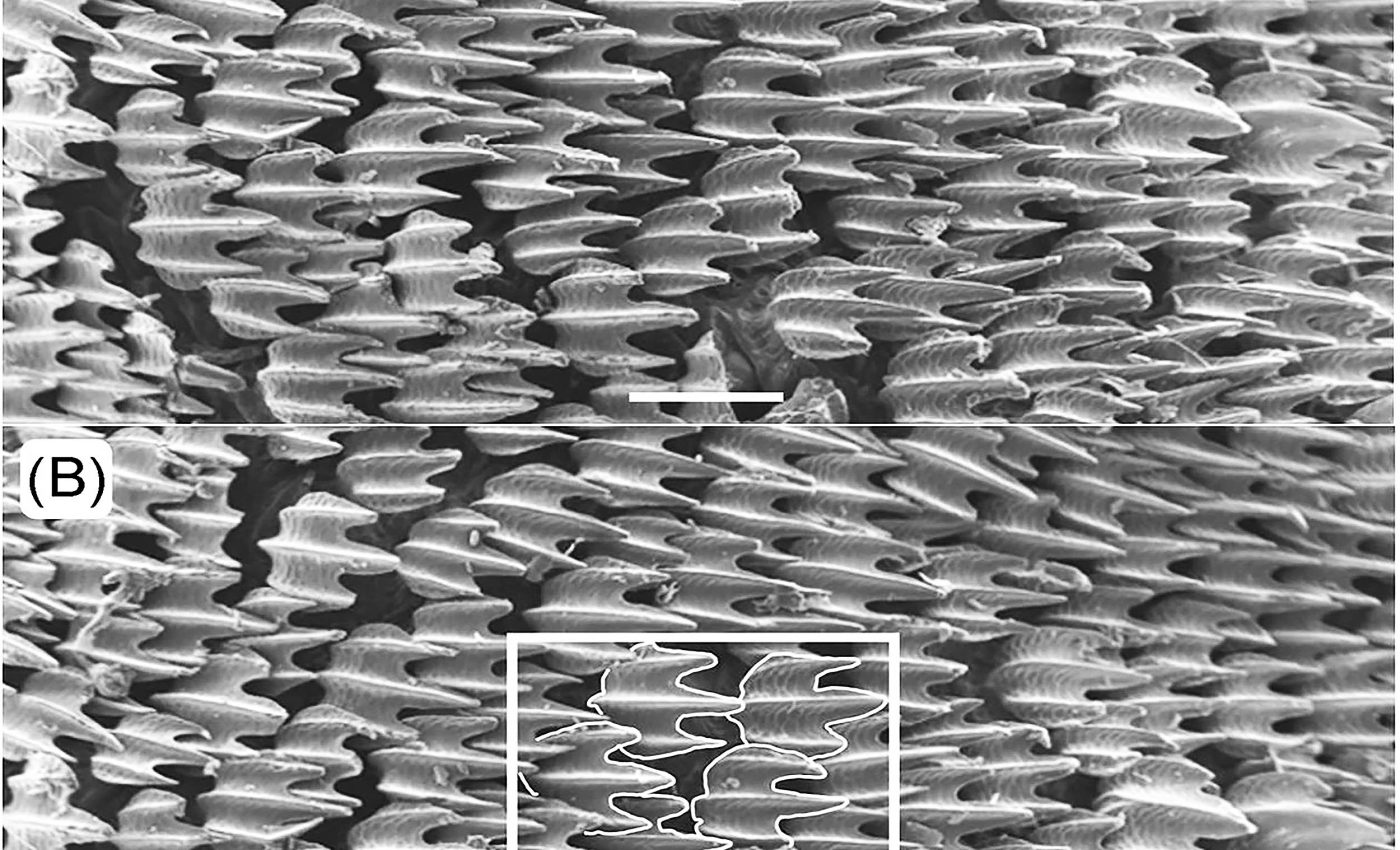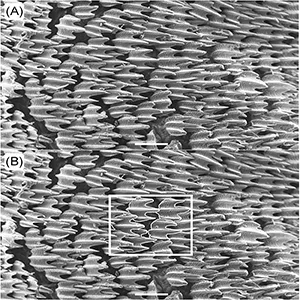
Ultra-magnified view of shark skin shows flexibility and resilience
What makes shark skin so tough and fast isn’t one thing but millions: dermal denticles, the tiny, tooth-like scales that armor a shark from snout to tail. They’re made of the same hard material as teeth.
Each denticle is etched with grooves that channel water, cut drag, and shield the skin – especially during the rough-and-tumble of mating.
Scientists have long known that denticles are key to a shark’s survival. What’s been missing is a clear picture of how those denticles change across the body as sharks grow. Researchers also don’t yet know whether males and females take different paths.
A team from Florida Atlantic University (FAU) set out to answer those questions, focusing on bonnethead sharks (Sphyrna tiburo), the smaller, shovel-snouted cousins of hammerheads.
With high-resolution scanning electron microscopy, they zoomed in on the sharks’ skin at life stages from juvenile to adult.
This method let them capture ultrafine details – denticle shape, ridge counts, overlap, and angles – that ordinary microscopes can’t resolve.
How shark skin adapts
Across 24 bonnethead sharks, the researchers documented denticles that don’t just enlarge but refit themselves for the job. As bonnetheads mature, their denticles gain more ridges and overlap more tightly, like shingles on a roof.
The ridge angles sharpen, but the overall denticle length stays the same. The effect is a surface tuned for better hydrodynamics and harder knocks.
Study senior author Marianne Porter is an associate professor of biological sciences at FAU.
“Shark skin is far more dynamic than people realize,” said Professor Porter. “Our study shows that as bonnethead sharks grow, their skin doesn’t just get bigger – it transforms in ways that improve swimming performance and provide greater protection.”
“These changes help reduce drag in the water and strengthen the skin against physical challenges like predators or mating-related injuries. It’s a remarkable example of how nature fine-tunes biological structures to meet the changing demands of an animal’s life.”
The team found that juveniles carry denticles with fewer grooves and less overlap. Their ridge angles are smaller too – traits that likely reflect different swimming needs and less exposure to abrasion and bites.
As sharks age, their skin upgrades its micro-architecture to meet adult pressures: longer swims, faster chases, sharper turns, and the rigors of courtship.
A soft divide in shark skin
Previous studies in other species have found that females often have thicker, tougher skin. Their denticles are denser too – perhaps as protection against bites during mating.
In bonnetheads, though, the sex split was muted. The only denticle trait that showed a clear difference was ridge angle, which ran slightly larger in males.
Across the abdominal region examined – dorsal, medial, ventral – the team found no significant sex-based differences in the suite of denticle features.
That nuance matters. Bonnetheads might depend on behavioral strategies or unsampled body adaptations to manage mating pressures.
It’s also possible their mating dynamics demand less pronounced armor differences than those seen in other sharks. Either way, it underscores that “sexual dimorphism” in shark skin is not uniform across species.

Microscopes reveal hidden armor
The work hinged on instrumentation that can turn a grain-of-sand surface into a city of structures.
FAU’s Marcus Research and Innovation Center provided the tools for the job. Its scanning electron microscope and morphometric software allowed the team see, measure, and compare denticle traits with micrometer precision.
Tricia Meredith, co-author of the study, is the director of research for Florida Atlantic Laboratory Schools and an assistant research professor at FAU’s College of Education.
“Using scanning electron microscopy and precise morphometric software allowed us to see and measure the tiny details of shark denticles like never before,” she said.
“This technology opens up new possibilities to understand how these structures function and evolve, giving us a clearer picture of shark biology and biomechanics.”
Patterns beyond bonnethead sharks
What the FAU team saw in bonnetheads mirrors a broader pattern: denticles evolve with life stage and lifestyle.
Portuguese dogfish, for example, cycle through 11 distinct denticle shapes as they develop. Juveniles in many species tend to carry smaller denticles that scale up – or remodel – as animals grow and their ecology shifts.
The bonnethead data fits that arc, adding new texture about how ridging, overlap, and angles change while overall length stays the same.
Those micro-adjustments are more than cosmetic. Ridges can trip tiny vortices that hug the skin, lowering drag.
Overlap can seal gaps that catch turbulence or expose softer tissue. Ridge angle can dictate how water streams past a moving shark or how the skin disperses force from a bite.
From sharks to swimwear, and beyond
Understanding denticle development isn’t just a marine biology win; it’s a blueprint for engineering.
“We can also apply these quantifications of shark skin to other fields, such as bioengineering, to specifically design materials that can help someone swim faster,” said corresponding author Hannah Epstein, a student at FAU.
Bioinspired surfaces are on the horizon. These coatings, designed with tuned ridges, shingled overlap, and optimized angles, could reduce drag on swimsuits, surfboards, drones, and underwater vehicles.
Tough, lightweight, laceration-resistant films that mimic adult denticle patterns might protect wetsuits or gear that takes a beating. Even medical devices could benefit from surfaces that repel fouling or modulate fluid flow.
Uncovering nature’s hidden designs
This project also showcases the Berlin Family Bioimaging Lab at FAU, a one-of-a-kind facility that gives students early access to high-end instruments. Such tools include micro-CT scanners, scanning electron microscopes, histology suites, and more.
With that platform, students like Epstein can jump into real research and publish in peer-reviewed journals while still in school.
By opening the ultrafine world of dermal denticles to scrutiny, the FAU team has shown how shark skin keeps reinventing itself – quietly, constantly, and with purpose.
For a fish that looks sleek from a distance, the secret is in the details you can’t see. Grooves deepen. Shingles tighten. Angles sharpen. Together, they form a living surface that grows into speed and strength.
The findings are published in the journal Integrative and Comparative Biology.
—–
Like what you read? Subscribe to our newsletter for engaging articles, exclusive content, and the latest updates.
Check us out on EarthSnap, a free app brought to you by Eric Ralls and Earth.com.
—–













